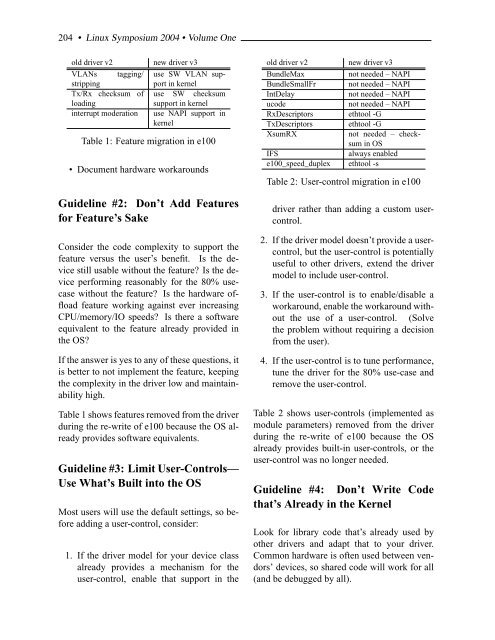You also want an ePaper? Increase the reach of your titles
YUMPU automatically turns print PDFs into web optimized ePapers that Google loves.
204 • <strong>Linux</strong> Symposium 2004 • Volume <strong>One</strong><br />
old driver v2<br />
VLANs tagging/<br />
stripping<br />
Tx/Rx checksum of<br />
loading<br />
interrupt moderation<br />
new driver v3<br />
use SW VLAN support<br />
in kernel<br />
use SW checksum<br />
support in kernel<br />
use NAPI support in<br />
kernel<br />
Table 1: Feature migration in e100<br />
• Document hardware workarounds<br />
Guideline #2: Don’t Add Features<br />
for Feature’s Sake<br />
Consider the code complexity to support the<br />
feature versus the user’s benefit. Is the device<br />
still usable without the feature? Is the device<br />
performing reasonably for the 80% usecase<br />
without the feature? Is the hardware offload<br />
feature working against ever increasing<br />
CPU/memory/IO speeds? Is there a software<br />
equivalent to the feature already provided in<br />
the OS?<br />
If the answer is yes to any of these questions, it<br />
is better to not implement the feature, keeping<br />
the complexity in the driver low and maintainability<br />
high.<br />
Table 1 shows features removed from the driver<br />
during the re-write of e100 because the OS already<br />
provides software equivalents.<br />
Guideline #3: Limit User-Controls—<br />
Use What’s Built into the OS<br />
Most users will use the default settings, so before<br />
adding a user-control, consider:<br />
1. If the driver model for your device class<br />
already provides a mechanism for the<br />
user-control, enable that support in the<br />
old driver v2<br />
new driver v3<br />
BundleMax<br />
not needed – NAPI<br />
BundleSmallFr not needed – NAPI<br />
IntDelay<br />
not needed – NAPI<br />
ucode<br />
not needed – NAPI<br />
RxDescriptors ethtool -G<br />
TxDescriptors ethtool -G<br />
XsumRX<br />
not needed – checksum<br />
in OS<br />
IFS<br />
always enabled<br />
e100_speed_duplex ethtool -s<br />
Table 2: User-control migration in e100<br />
driver rather than adding a custom usercontrol.<br />
2. If the driver model doesn’t provide a usercontrol,<br />
but the user-control is potentially<br />
useful to other drivers, extend the driver<br />
model to include user-control.<br />
3. If the user-control is to enable/disable a<br />
workaround, enable the workaround without<br />
the use of a user-control. (Solve<br />
the problem without requiring a decision<br />
from the user).<br />
4. If the user-control is to tune performance,<br />
tune the driver for the 80% use-case and<br />
remove the user-control.<br />
Table 2 shows user-controls (implemented as<br />
module parameters) removed from the driver<br />
during the re-write of e100 because the OS<br />
already provides built-in user-controls, or the<br />
user-control was no longer needed.<br />
Guideline #4: Don’t Write Code<br />
that’s Already in the <strong>Kernel</strong><br />
Look for library code that’s already used by<br />
other drivers and adapt that to your driver.<br />
Common hardware is often used between vendors’<br />
devices, so shared code will work for all<br />
(and be debugged by all).

















